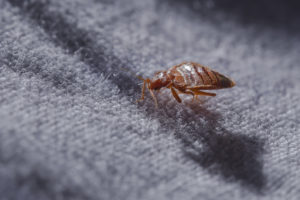
Vlue / Shutterstock.com
When I was a college sophomore, an acquaintance of mine from the adjacent dorm building noticed nasty bites all over his body. He assumed that whatever he was going through was an isolated incident—spider bites, maybe—but what he didn’t know was that other residents in the building were also being bitten at night. By the time they banded together and figured out that bedbugs had moved into their dorm, the ruthless little creatures had taken over the top two floors of the building. The word got out, and soon everyone at school knew about the infestation. “Don’t go in there,” we nonresidents would whisper ominously to each other when we walked past the place. “That dorm has bedbugs.”
Few outbreaks are feared more by college students than bedbugs. Not only are they keen to spread and difficult to treat, but bedbugs come with a social stigma. We think of them as indicators of filthy homes and dirty dorm rooms, but it’s not nearly that simple. So, what is the deal with bedbugs, and more importantly, how do you deal with them if you have them? Good questions. Let’s start from the beginning.
What are bedbugs?
Belonging to the Cimicidae family, bedbugs are small, wingless insects that feed on blood (read: they’re parasites). While several species of bedbugs exist, there are two in particular that prefer human blood: Cimex lectularius (typically found in temperate regions) and Cimex hemipterus (found in tropical regions). Both species are stealthy.
Their modus operandi is the sneak attack—the “dine and dash,” if you will. It takes bedbugs only a few minutes to feed on a human, and they promptly retreat to their hiding places (beds, couches, walls, any place strategically close to their food source) when they’re full. To make matters worse, bedbugs are nocturnal creatures, preferring to eat before sunrise, so their “victims” are usually sleeping during the whole ordeal.
What do bedbugs look like?

Akos Nagy / Shutterstock.com
If you can stomach it, a Google image search will tell you all you need to know. But if you’re already shuddering just thinking about the creepy crawlies, better to just keep reading.
Bedbugs aren’t cute, not even when they’re babies. Bedbug eggs are pearly in color, and in shape, they resemble a gelcap pill or a grain of rice, but they are much, much smaller; you probably wouldn’t notice a stray egg without a magnifying glass. If you think you have bedbugs, best look for the adults. While there is some variation between the mature males and females (the latter are bigger), they both have noticeable antenna on their heads, six legs, and pronounced abdomens. Here’s the kicker, though. Unfed bedbugs are flat and their abdomens are so wide that they’re almost circular. Much like filling a pool toy with air, however, as a bedbug fills its belly with blood, its abdomen stretches out to accommodate the meal. It truly gets a food baby.
If you find bedbugs in your dorm, you might notice that some are reddish brown and others are a translucent tan. The former are the adults at maturity; the latter are the kids and teens. None of them are innocent; all of them want to feast on your blood, which they need to reach maturity and lay eggs.
How do you get bedbugs?
Bedbugs spread easily. While they can’t fly, they hitch rides to their new homes on clothing and in suitcases or secondhand furniture. That’s why, if you have bedbugs, it’s so difficult to figure out how you got them. A friend may have brought a pair into your home on her clothes, for example, or you might have picked them up while sitting on public transit or in someone else’s car. If you’re living in the dorms, it’s possible that your neighbor’s bedbugs simply found a shortcut from his room to yours. You might never know how they found you.
Bedbugs are spread accidentally (almost always, at least), and having bedbugs does not mean you are unclean or dirty. It just means that through an unfortunate series of events, the bugs happened upon your room and approved of having you as their new food source.
What do bedbug bites look like?
If a bedbug does bite you, it not only sucks your blood, but it also injects the proteins from its saliva into your body. Its properties are both anticoagulant (to keep your blood flowing so that the bugs can keep feasting) and anesthetic (to keep you from noticing the bites as they happen). Everyone reacts to these proteins in different ways, meaning that some people will develop symptoms within hours and others will develop them a few days later. Reactions also vary based on the number of times you’re bitten, how often you’ve been bitten by bedbugs before, etc.
In general, bedbug bites cause rows of small, red welts to appear on your skin. This is because an individual bedbug may bite you several times as it walks across your body in search of the perfect blood vessel. Sometimes the bites cause swelling, burning, and/or itching. Scratching or picking at the bites can only exacerbate your symptoms and make you susceptible to secondary infection.
What should I do if I think I have bedbugs?
While bedbugs don’t transmit diseases to humans, they are still a public health issue because they spread so easily and are difficult to get rid of. This is bad news bears for students who live in dorms and apartments because infestations that aren’t treated immediately can quickly take over the entire building. (I wasn’t exaggerating that time bedbugs infested my alma mater.) If you think you have bedbugs, you need to take action ASAP.
If you live on campus, alert your school’s office of residential life, which will have policies in place for pest management. If you live off campus, contact your landlord. If you’re a homeowner, no one is going to arrange a bedbug treatment for you, so call a pest control company directly. And do it today.
The person you contact will arrange to send an exterminator to your room, apartment, or home. During this initial inspection, the exterminator will look for signs of bedbugs (the bugs themselves or their skins, eggs, or excrement) to determine if they are indeed camping out in the area. If no evidence of bedbugs is found, no further action will be taken, and you’ll need to consider other possible suspects. If the exterminator does find evidence of bedbugs, your room will need to be thoroughly treated for the pests.
How do you get rid of bedbugs?
Bedbugs aren’t going anywhere unless you and the exterminator work together. Based on where the bedbugs are hiding, how many there are, etc., pest control will implement a treatment to target the specific infestation, and you’ll likely be instructed to prepare your room for the treatment. Typically, you will need to wash and bag all of your clothes and bedding. Sometimes, you will need to remove books and other belongings from your room. It’s also important that you continue to sleep in your room unless pest control advises you not to. It seems counterintuitive, but if you sleep on a friend’s floor until your bedbug infestation is gone, you might be putting your friend’s room at risk. (Bedbugs love to branch out, remember?) After pest control treats your room, the exterminator will return for a follow-up visit to make sure that the treatment was successful.
How much does it cost to treat bedbugs professionally?
It depends on many factors, including where you live, the size of the infested area, the treatment plan, how many treatments are necessary, the pest control company you choose, etc.

wavebreakmedia / Shutterstock.com
If you live in on-campus housing, residential life may take care of the costs for you. The office might even pay for you to launder your clothes. Of course, these policies vary by school, so check with yours. Apartment complexes are less generous. My old apartment complex used to charge tenants $400 if their place needed a bedbug treatment, which a tenant could pay in monthly quotes of $100. Needless to say, the complex did not offer free laundry services to those affected. It’s hard to say if these costs are typical or not since so much of it depends on where you live and the size of your apartment. Check your lease or ask your landlord for specific figures. Similarly, if you’re a homeowner, you’re going to have to take charge of the costs yourself, and you’ll likely find that the bigger your house, the bigger your bill.
It should be noted that you can pick up various bedbug killers and sprays from your local hardware store or online for less than the cost of a professional treatment. I’m hesitant to recommend these products, however. While some reviewers rave about them on Amazon, others suggest that these products just keep the bugs at bay. If your school is offering you free, professional pest control, please choose that option as it will best ensure that the bugs won’t spread to other dorm rooms. I’d say that professionally treating your apartment is also common courtesy for the other tenants in your building, but if you own your home and you’d rather treat the infestation yourself, well, that’s your call.
Dealing with bedbugs in college or on your own isn’t fun, but the sooner you do it, the sooner you can recover your peace of mind. In the meantime, sleep tight and don’t let the bedbugs bite!
-
What Every College Student Should Know About a Lease Agreement
-
Successfully Apartment Hunting Using Craigslist: It’s Possible
-
Tips to Simplify Your College Packing Experience
-
What It’s Going to Cost You to Move into Your First Apartment
-
How to Not Be a Terrible Roommate
-
Should You Get a Pet in College?
-
Must-Have Skills for Living on Your Own the First Time
-
Tips to Help You Successfully Pack for College
-
Nine Apps that Will Keep You Safe on and off Campus
-
Eight Must-Have Features in Your College Apartment

